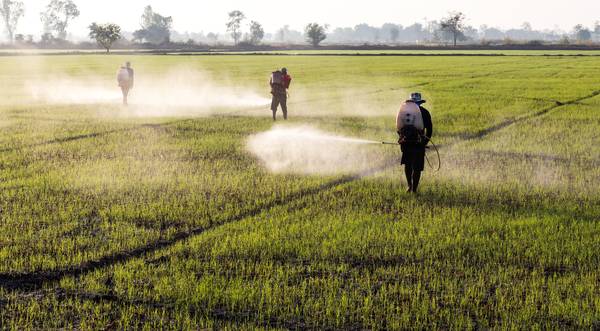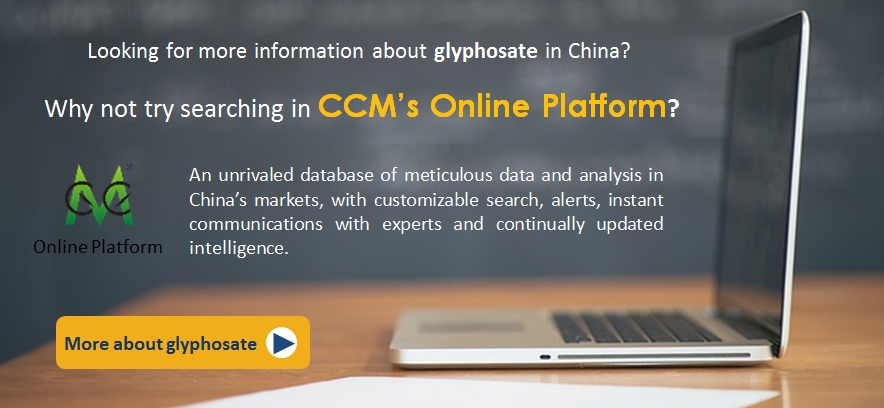With
new environmental inspections arising in China's major pesticide production
regions, the upward trend of glyphosate price will likely continue rising in
the second half of 2017. The traditional peak season for glyphosate as well as
huge mergers in the industry is supporting the development.

According
to market intelligence firm CCM, the fourth round of China's environmental
inspections has been launched in the middle of August, It is worth noticing,
that two provinces three are in the center of the new inspections, are
Zhejiang, Shandong, and Sichuan, whose represent the main regions of China's
pesticide production with more than one-third of the national output. The
increased environmental investigations will un-doubtfully increase the pressure
on the manufacturers and affect the supply of glyphosate and its raw materials
negatively, which supports further price hikes in H2 2017.
Due
to the high waste occurrence in the glyphosate production process,
manufacturers without qualified pollutant treatment facilities have to cut or
suspend production under heavy environmental pressure.
In
the first half of 2016, the Chinese glyphosate demand was sluggish, which
caused a slowing-down of the production as well. The average price of
glyphosate even fell by USD2,878 per tonne in 2016, which represents the lowest
level for three years. After the drop, however, the Chinese glyphosate market
recovered again, which is mainly due to the decrease of the inventory as well
as the ban on paraquat AS, which turned many clients to switch to glyphosate as
a replacement. Then in July and August, when the production was further
restricted, another round of price rise arose throughout the entire glyphosate
market.
Production
problems of glyphosate in China are one of the main reasons for rising
glyphosate prices in the second half of 2017. Raw material costs in China, for
example for glycine and paraformaldehyde, are still on the rise since the
beginning of 2017. In China, manufacturers mainly produce glyphosate from
glycine or iminodiacetic acid. The glycine production line hereby accounts for
a 70% proportion. The price hikes follow the stricter environmental
regulations in the country and especially the region with the highest
production share, Hebei Province. The lowered operation rate of the
manufacturers in this province has caused lower supply and shortage, which
pushes the price.
In
the coming period of 2017, CCM expects that the domestic glycine prices will
further go up, given continuously strict environmental regulations in leading
producing provinces. Particularly, Hebei, which possesses a glycine production
capacity of 240,000 tonnes per year, which represents 40 percent of the
national total, may experience heavier environmental pressure and longer
production suspension during heating season over 2016.
A
strengthening market demand for glyphosate is another factor to drive the
prices up. Domestic-produced glyphosate, which is traditionally mostly exported
to overseas markets, has its peak sales in the third quarter each year. Yet,
affected by the previous low price, producers had maintained low operating
rate, reducing the overall market inventories. Thus, further shortage in supply
can be expected during the 2017 peak export season.
Large Mergers
Another
factor that may keep the international glyphosate prices and the prices of
other herbicides and pesticides high, is the occurrence of mergers by huge agrochemical companies in these days. Notable are hereby the merger of
ChinaChem with Syngenta, Dow Chemical with DuPont, and Bayer with Monsanto. The
large merger will without any doubt reshape the current global agrochemicals
and seed market, with fewer but stronger enterprises control the prices and
supply of their pesticide products for the world market. The huge enterprises do
sell their genetically-modified seeds and promote the pesticides that are
working well together, like Monsanto's famous glyphosate containing Round-up.
When fewer enterprises control the seeds and related pesticides, the supply and
price competition may fall, which will keep prices high as a result.

Global
glyphosate market share remains highly concentrated with four companies
catering to 50% of global revenue in 2015. Monsanto, DuPont and Dow
AgroSciences are the main industry players.
Concern in the European
Union
The
European Union is pending the further approval glyphosate usage on European
fields by the member states support, according to Reuters. The European risk
assessment committee has recently proposed to label TiO2 as a carcinogen,
backed up by laboratory results made on rats. The Agency states to have the
scientific evidence, that TiO2 can cause cancer through the inhalation route,
which would cause the classification in Category 2. The justification to
classify the substance responsible for growing cancer, however, was repelled by
the agency due to lack of evidence. As a result, the EU has no reason to doubt
glyphosate is safe and can be approved by another 10 years, but the final
decision depends on the approval of the national governments. According to
Reuters, the EU member states have consistently failed to agree on a majority
firmly in favour or against approving glyphosate.
In
China, glyphosate is mainly used for the treatment of maize, wheat, cotton,
sunflower, and sorghum. The size of the glyphosate market was more than USD400
million in the year 2015, which is mainly due to the growing food consumption in the country with a small percentage of arable land available. Worldwide, the
market of glyphosate is expected to grow at a CAGR of more than 5% to
2024.
About CCM
CCM
is the leading market intelligence provider for China's agriculture, chemicals,
food & ingredients and life science markets.
Do
you want to find out more about the glyphosate market in China? Try our Newsletters and Industrial Reports or join our professional online platform today and get insights in Reports, Newsletter, and Market Data at one place.
For
more trade information of pesticides, including Import and Export analysis as
well as Manufacturer to Buyer Tracking, contact our experts in trade analysis to get your answers today.